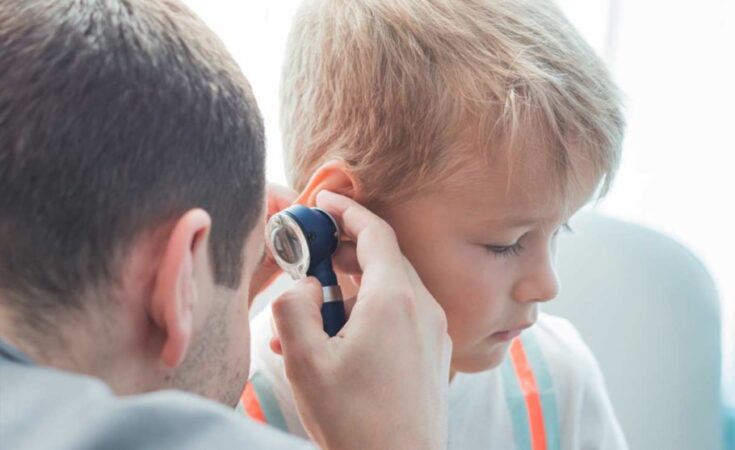Otitis media is the inflammation of the middle ear, the area behind the eardrum (middle ear). It is often associated with fluid buildup in the ear and can be with or without infection.
Otitis media is common in infants and young children, as the eustachian tube, a passage from the middle ear to the throat, is smaller and horizontal in children than in adults. This blocks fluid drainage in the ear during upper respiratory infections and colds.
Read this post to learn about the types, causes, symptoms, diagnosis, treatment, and prevention of otitis media in children.
Types Of Otitis Media
There are three types of otitis media with different combinations of symptoms.
Acute otitis media (AOM) is the most common type of ear infection and is characterized by abrupt redness and swelling in the ear. Fluid can be trapped behind the eardrum in AOM, leading to ear pain (earache) and fever in children.
- Otitis media with effusion
Otitis media with effusion (OME), also known as serous otitis media (SOM), occurs when mucus and fluid (effusion) continue to accumulate in the middle year even after the infection resolves. This may make the child feel as though the ear is full and often impair hearing. Sometimes, no symptoms are seen in OME and may be found only during ear examinations.
- Chronic otitis media with effusion
Chronic otitis media with effusion (COME) occurs when the fluid remains in the middle ear for a prolonged period or builds up repeatedly even without an infection. COME can affect the child’s ability to fight new ear infections and may impact their hearing.
Causes And Risk Factors For Otitis Media
Malfunction of the eustachian tube, which connects the middle ear to the throat area, is the most common cause of middle ear infections (otitis media) in children. This can lead to fluid build-up in the middle ear, the area behind the eardrum. Accumulation of fluid can facilitate bacterial and viral growth in the ear and lead to acute otitis media.
The eustachian tube equalizes the pressure between the middle ear and the outer ear and drains the middle ear secretions to the nasopharynx (upper part of the throat). The following reasons may obstruct the drainage of secretions from the middle ear.
- Malformation of the eustachian tube (anatomical defects)
- Swelling and congestion of the nose, throat, and eustachian tube due to allergy or cold
Although many children can develop an ear infection, the following factors may increase the risk for it.
- Positive family history of middle ear infections
- Exposure to secondhand smoke
- Bottle-fed while laying on their back when young
Signs And Symptoms Of Otitis Media In Children
The following signs and symptoms are commonly seen in otitis media. However, note that the symptoms of otitis media may vary in each child based on the type, severity, and cause of infection and may affect one or both ears.
- Fever, more common in young children
- Tugging or pulling the ears
- Fluid discharge from the ears
Consult a pediatrician for an exact diagnosis since these symptoms can also be seen in other medical conditions.
Can Ear Infections Affect Hearing?
Mild hearing loss that comes and goes is often seen in middle ear infections. However, the impaired hearing gets better after the infection subsides.
Sound vibrations from outside the ear are carried through three tiny bones in the middle ear to the inner ear. Fluid buildup in the middle ear may reduce sound transmission, often leading to moderate or mild hearing loss. This type of hearing loss is called conductive hearing loss.
Permanent hearing loss may occur if a child has permanent middle ear structure or eardrum damage. Tearing of the eardrum due to otitis media may also impair hearing. However, this may heal on its own or can be repaired through surgery.
Other Complications Of Otitis Media
Hearing impairment in young children can impact their speech and language development and also cause a delay in developing other milestones and social skills in young children.
Untreated middle ear infections can spread into nearby tissues and often result in mastoiditis (infection of the mastoid bone behind the ear) and meningitis (infection of the brain membranes).
Diagnosis Of Otitis Media
Doctors may inspect a child’s ear using a pneumatic otoscope, an instrument with a light, to diagnose otitis media. This may help visualize changes, such as redness, bulging, or opaque fluid due to middle ear infection. In addition, the doctor may obtain the child’s complete medical history.
Hearing tests or referrals to a specialist are recommended for children with chronic fluid acculturation in the ear and frequent ear infections since these may lead to hearing impairment in some cases.
Tympanometry, a test to measure the pressure in the middle ear to understand middle ear functioning, may also be performed. However, this test does not determine hearing in children and is often impossible in young children since they have to stay still without talking or moving.
Treatment For Otitis Media In Children
Antibiotic therapy is not recommended for children aged two to 12 years and with mild symptoms. However, older children or those with severe symptoms of otitis media receive seven to ten days of antibiotic therapy.
Analgesics (pain relievers) such as ibuprofen or acetaminophen are prescribed for earache. Ear examinations are repeated after 48 to 72 hours of treatment, and intramuscular antibiotics are given if the symptoms persist.
Doctors may consider tympanocentesis, removing fluid behind the eardrum, in some children. A tympanostomy (surgical opening in the eardrum) tube is placed in children with bilateral otitis media and effusion lasting for more than three months and with hearing difficulties to drain the fluid.
Prevention For Otitis Media In Children
The following measures may reduce the risk of middle ear infections in children.
- Prevent common colds and other respiratory infections by teaching your child proper hygiene practices.
- Do not smoke indoors or near children.
- Bottle-feed young children in an upright position.
- Get vaccinations such as a pneumococcal vaccine, seasonal flu shots, and other vaccines to prevent ear infections.
- Exclusively breastfeed a child until six months if possible since they get protective antibodies.
Otitis media in children requires medical care and draining of effusion if present. If left untreated, it may impact a child’s hearing and language development. Childhood immunizations may protect children from various upper respiratory tract illnesses that cause otitis media.
References:
MomJunction’s health articles are written after analyzing various scientific reports and assertions from expert authors and institutions. Our references (citations) consist of resources established by authorities in their respective fields. You can learn more about the authenticity of the information we present in our editorial policy.



































